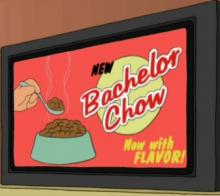In the once-underrated, now-beloved show Futurama, a foodstuff of questionable content called Bachelor Chow is a fixture in the life of lazy everyman Philip J. Fry. It's a joke predicated on the comical loneliness and carelessness of the life of a single man, but it also comes from a deep seated and rarely acknowledged fantasy for such a substance to exist. The real world is full of food products marketed to men who would likely pick up a package of Bachelor Chow if it existed, but most of those things aren't terribly healthy or tasty. It's time to fix that. Herein you will find a recipe for an actual rendition of Bachelor Chow.
First, we need to define what Bachelor Chow ought to be. Primarily, it ought to be a sort of mush. It's meant to be consumed in a bowl or, better yet, straight from the package with little more than a spoon or spork. It also has to be palatable both warm or cold. Most importantly, the stuff has to be nutritious. Plenty of things can be made into a composite paste and shoveled into the mouth of a hungry bachelor, but the man needs his vitamins and protein just like everyone else.
So, let's establish a base element. This is going to be the medium by which everything else about the Bachelor Chow will be delivered. The knee-jerk idea is potatoes, as they mash easily and tend to play well with other flavors, but I'm going to reject that idea. It's too much starch and it's too heavy. Sweet potatoes or yams would be healthier and more flavorful, but those flavors would be a little too distinct and make the dish inflexible. No, my recipe opts for cornmeal mush. This stuff is pretty amazing on its own and is sorely under-utilized in the kitchen. Made by slowly heating a measure of cornmeal with water and salt, maybe a pinch of sugar and some butter, cornmeal mush is versatile and tasty. It's the basis for corn fritters, pudding and a wide variety of other dishes. It's not bland like potatoes or flour but it's also not strongly flavored on its own. As a bonus, it's easy to control how solid it sets up upon cooling by changing the cornmeal to water ratio.
Now that we have our base, it's time to up the nutrition. This is when we bring out our blender to make a vegetable puree. A collection of healthy, tasty veggies stir fried and blended to a smooth consistency will go great with the cornmeal mush and will still mix well with other, stronger flavors down the road. A mix of broccoli, carrots, onion, garlic, bell peppers and zucchini should work out nicely. Stirred to combine with the cornmeal mush, we're well on our way to functional Bachelor Chow.
Adding protein is a bit more tricky, but we have several options. There are simple approaches like a lazy chili of beans and 80/20 ground beef, but we can go for other flavors with unsweetened nut paste or vegan products like seitan or tempeh to give the chow a longer shelf life than meat will allow. Hitting the "plain" meal-and-vegetable chow with some Greek yogurt will also do the trick. We could go for whey, but that's boring and not terribly appetizing.
Lastly, there's the issue of flavor. On its own, Bachelor Chow won't have a whole lot of taste. There'll be some from the vegetable puree depending on the proportions of garlic and peppers, but maybe blandness is a good thing in this case. Bachelor Chow is meant to be a lazy, not at all exciting product designed to merely keep slobs alive. Also, it wouldn't be hard to hit a bowl of chow with one's sauce of choice or a dash of bottled spices.
It may not be the food of the future, but I think this recipe for Bachelor Chow is perfectly functional. It's natural, nutritious and flexible, which is about as much as we can ask for.
